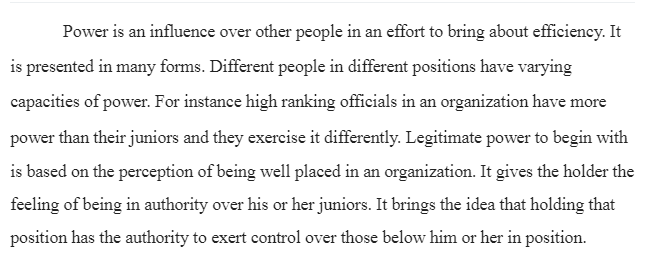Position and Sources of Power
Power is a leader’s influence over their followers. While power has the potential to control others, it is the perception of power rather than the actual use of it that can influence, manage, and move people and organizations to a higher level of efficiency.
Do the following to complete this assignment:
- Discuss the differences between legitimate, reward, coercive, and referent power. Give an example of each or the appropriate uses of these expert powers. Include responses to the following:
- Explain how they are similar and how they are different.
- Describe your experience with these types of power.
Write your initial response in a minimum of 200–300 words. Apply APA standards to citation of sources.
Beginning Saturday, February 27, 2016, post your responses to the appropriate Discussion Area.Through Wednesday, March 2, 2016, comment on at least two of your peers’ responses.
Do the following when responding to your peers:
- Read all posts from your peers.
- Respond to feedback on your post and provide feedback to other students on their ideas.
- Provide substantive comments by contributing new, relevant information or quotes from course readings, academic and trade journals, company websites, or other sources; building on the remarks or questions of others; or sharing practical examples of key concepts from your professional or personal experiences.
- Make sure your writing is clear, concise, and organized; demonstrates ethical scholarship through accurate representation and attribution of sources; and displays accurate spelling, grammar, and punctuation.
Answer Preview-Position and Sources of Power

